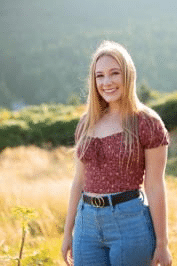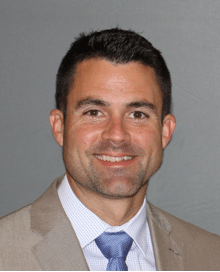Student Leadership Makes an Inclusive Impact at Elizabethton High School
For many students across the country, summer 2021 looked a little different than most. Still, teen summer plans do not generally include a seat at the district board meeting table or meetings with the superintendent discussing the logistics of federal relief dollars. However, for high school seniors Maggie Cole and Morgan Guinn, that is exactly what their summer had in store.
Elizabethton School District (Tennessee) has an elected high school student liaison who represents the school’s teachers and students as a non-voting member at district board meetings. During the July board meeting, Elementary and Secondary School Emergency Relief (ESSER) funds were discussed.
Maggie: As a student liaison, I connect the students to the people that are making decisions for the students. I make sure the decisions made in school board meetings both reflect the student input and are targeted with students at the center. Though I officially started as a liaison in August, because meetings concerning funding and fall decision making were happening in June and July, I began going to meetings and working as a student liaison over the summer.
Morgan Guinn, Elizabethton High School’s student body president, works closely with Maggie to address urgent issues and provide perspectives gleaned from her role in student government.
Morgan: If we have a big issue we want to work on, we come together and I use my role as student body president to get the teachers and other administrators involved. And then she (Maggie) listens and can bring those forward to the school board. And so we just kind of bring those together—and we get things done.
An important support role in this process was high school librarian, Dustin Hensley. Hensley serves as a facilitator to the student liaison, helping provide relevant background knowledge or a listening ear to liaisons crafting board proposals. When Hensley saw ESSER funding on the July agenda, he knew student input was necessary.
Maggie and Morgan eagerly took up this opportunity. Hensley remembers Maggie confidently approaching Richard VanHuss, the district superintendent, at the end of the July meeting. She implored VanHuss to look into the student perspective. VanHuss then called a follow-up meeting with the high school principal, Maggie (liaison), and Morgan (student body president) to discuss how the funds could be used.
During the meeting, VanHuss shared a breakdown of how ESSER funds could be used and explained them, in great detail. Maggie and Morgan responded with questions and excitement surrounding the opportunity of these funds. They also reviewed responses from parents and community members concerning this funding.
Maggie: After the meeting, I talked with Mr. Hensley about getting students involved, informing them about the opportunities these funds could bring about in our school. We reached out to students via Instagram and our school’s messaging systems, asking them what they believed these funds should be used for. We reached out to friends and people who were involved in the school, asking their perspectives and opinions, and are still working to supplement the school’s digital suggestion box for students with a physical version.
Morgan: The students who responded were pretty unanimous: Many brought up the CTE (Career and Technology) department and the current state of the bathrooms. Dr. Minton and Mr. VanHuss thought it was good to gather multiple ideas/perspectives, but advised us to try to narrow in on one major action. After a few emails discussing our findings and decision, the four of us reconnected and decided to focus on addressing the current state of the school bathrooms, as many students cited their discomfort and lack of accessibility.
Maggie: Together, we all went into the bathrooms. We (Maggie and Morgan) had never been to the boys bathroom and they (Mr. VanHuss and Dr. Minton) had never been in these bathrooms either, so we both had a chance to see how bad of shape they were in—especially the girls’ bathrooms. We went through and documented the issues, discussing how they might change.
One example of this was the lack of feminine hygiene products. The administration was under the initial impression that these were available in bathrooms, but that was not the case. We (Morgan and Maggie) wanted to make these products more easily accessible. We provided the perspective that even though counselors’ offices have these products, their offices are on the other side of the building.
Morgan: We asked the boy students’ perspectives as well. We wanted all students to feel comfortable in these bathrooms. For many it was as simple as a solution for privacy. Students said that they just wanted to be able to close the door—and in the boys’ bathrooms, they wanted to have working stalls. Maggie and I made a PowerPoint presentation that explained each of our ideas on how to update these bathrooms.
We also thought this would be a great place to get students involved. After the past year, our student body has really gotten excited about in-person or community building events. With student volunteers, we got the labor we needed to fix the bathrooms as well as provide community service hours to students doing the work. This led to creating the Student Committee for Volunteers, with the bathroom update as their first project.
The new committee provided a place for students to come together—whether people needed volunteer hours or just wanted to help improve the school. The committee also hosted a club fair event this fall, offering students a place where clubs of all kinds got to come together and share their interests. This was an event we hosted on a Saturday evening, and it was open to the public. There were a bunch of fun interactive stuff to do for participants, like a flight simulator set up by the Aviation Club, but the event succeeded in bringing awareness to the clubs.
Throughout the fall, Maggie and Morgan have met with the school architect to discuss bigger changes to the school bathrooms such as providing doors on all bathroom stalls. Both students spoke of their patience with completing this project the right way, even if it took a little longer than expected. They also feel proud of how this initiative set a precedent of student-driven change for issues and opportunities in the future.
Resources
About The Author
Maggie Cole, Student Board Member, is a senior at Elizabethton High School. She is the section leader of the front ensemble in the Betsy Band, leading the keyboards in the front of the field during football games. She has played piano for about 12 years and enjoys playing for friends and family, and at church. She is involved in a student leadership group at her church, planning fun events and volunteer opportunities for the youth group. She is also a member of the church’s youth praise band. After graduating high school, Maggie plans to attend the University of Tennessee and major in speech pathology.

Morgan Guinn, Student Body President, is a student at Elizabethton High School. She is president of the Student Body and National Honors Society. She also serves on the board for Key Club, is a varsity cheerleader, and captain of the color guard in the Betsy Band. Guinn uses these roles to promote student voices and changes all around the school.

Dustin Hensley, Library Media Specialist, is currently in his seventh year as Librarian at Elizabethton High School. In 2021, he was named as one of Library Journal’s Movers and Shakers in the field of librarianship for his work with student voice and developing growth mindset.

Mr. Richard VanHuss, Elizabethton City Schools Superintendent, is an Elizabethton native and 1990 graduate of Elizabethton High School (EHS). He holds a BS in Mechanical Engineering from the University of Tennessee (1995), Master of Education from Milligan College (1997), and an Educational Specialist Degree in Educational Administration & Supervision from Lincoln Memorial University (2010). During his 25 years at Elizabethton City Schools, he has served as a Mathematics Instructor and an Assistant Principal at EHS, before moving to the Central Office. He supervised a variety of departments before being named Director of Schools in 2020. He has served on the Elizabethton/Carter County Chamber of Commerce Board of Directors and is a current board member of the Elizabethton/Carter County Lions Club. His wife, Crystal, is a physical education instructor at West Side Elementary School. They have two children, Bryce and Bailee, who are students at EHS. They are active members of Oak Street Baptist Church

Dr. Jon Minton, Elizabethton High School Principal, is in his third year as a school leader at Elizabethton High School and 17th year in education. His classroom experience began as a teaching assistant in 2004 supporting students with disabilities and, upon completion of his master’s degree in school counseling, Jon transitioned into the role of high school counselor at Unaka High School for eight years while also serving as a coach of multiple sports and athletics director. His leadership experience began in 2013 as the principal of Happy Valley Middle School. After four years serving teachers and students in grades 5-8, Jon was given the opportunity to lead as an Assistant Principal of Facilities and Operations at Science Hill High School from 2017 through 2019, leading him to his current role as Principal at Elizabethton High School. Jon engaged in contract work with the Tennessee Department of Education, leading standards-based restructuring in the first core region of Tennessee, and currently serves as the Principal Study Council Chair for the respective region. Jon has been married to his wife Cassie, also a teacher, for 14 years and they have two children, Sydney and Rylee.
